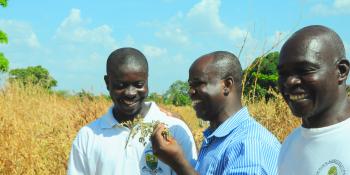Agroclimatic information helps prepare for El Niño in Central America

Research on climate variability contributes to improving adaptation measures for farmers and institutions in the region.
Reduction in production levels due to the scarcity of water for crops, decrease in herds due to inadequate food and water for livestock and increased risk of forest fires due to drought, are some of the consequences that come with the El Niño phenomenon for the agricultural sector of Guatemala, due to the reduction of water levels.
El Niño refers to warmer-than-normal sea surface temperatures in the eastern tropical Pacific Ocean. La Niña, the opposite of El Niño, signifies periods when the eastern equatorial Pacific is cooler than usual.
Following similar problems of climate variability throughout the region, the International Center for Tropical Agriculture in Central America (CIAT) through the Decision and Policy Analysis (DAPA) Research Area, is carrying out studies on water balance and monitoring climatic data, in order to contribute to the development of an agroclimatic bulletin that will later be distributed to local producers and partners to contribute to the processes of climate adaptation in the region.
The studies are also within the framework of the "A Common Journey" project of the CGIAR Research Program on Climate Change, Agriculture and Food Security (CCAFS) and is financed by the International Fund for Agricultural Development (IFAD).
These studies will be carried out in the four countries prioritized by the project: Guatemala, El Salvador, Honduras, and Nicaragua. The bulletins will include the following information:
- Summary with the possible effects of the climatic conditions of El Niño / La Niña, during 2019.
- Climatic perspective and crop model for corn and beans.
- Pre-sowing calendars for both crops, prepared with the support of local actors
- Recommendations for sowing by crop.
For the construction of this document, meetings in the framework of Local Technical Agroclimatic Committees (LTAC) for each country were planned, through which possible to find adaptation measures for their region and crops, based on the agro-meteorological projections for the next months. The main objective of this activity is to strengthen the capacities of partner institutions, through its technicians and producers, about agroclimatic forecasts, collection, management, analysis and interpretation of climate and agricultural information.
LTAC in Somotillo, Nicaragua
On March 15, in Chinandega Norte, in the municipality of Somotillo, the first LTAC of 2019 was held. The purpose of the activity was to prepare the planning of activities prior to the first cycle, generating an agricultural calendar for corn and beans, pre-sowing. From the inputs generated by the researchers, plus the systematized information from the LTAC, an agroclimatic bulletin is being prepared and is already being reviewed and discussed by the DAPA-CIAT team and key partners.
The activity began with a description of all the components and, the activities that will be carried out in the framework of the project. The importance of the involvement of CIAT-CCAFS, within the LTAC, in terms of expected results was also highlighted.
The following presentations took place during the session of the LTAC:
- Description of the project, results, and components (by Armando Martínez, Project Coordinator).
- Agroclimatic Forecast 2019 (by Carlos Zelaya, Specialist in Agrometeorology).
- Corn and bean cultivation models (by Josué Rodríguez, Specialist in GIS and Models).
- Local knowledge: Work in groups to discuss calendar for recommendations of sowing dates.
Continuing with the activities, on March 22, the CIAT-CCAFS team met again with the members of the LTAC with the objective of presenting the results of the agroclimatic bulletin and to implement the first Workshop on Prioritization of climate-smart agriculture (CSA) in the region.
Then, on March 26, in Cholutecam, Honduras, the CIAT-CCAFS team joined the Environment and Climate Change Board (AGRACC), led by the Coastal Watershed and Livelihoods Improvement Project (CODDEFFAGOLF) and made up of a total of 30 local organizations. On March 29, a local training workshop for technicians and promoters was held in Choluteca, about the Kobotoolbox crop monitoring tool developed by the Harvard Humanitarian Initiative that collects reliable information in a humanitarian crisis, especially following a natural disaster.
Read more:
- News update: Guatemala implements a food security monitoring and early warning system supported by Bioversity and CCAFS
- News update: Exploring the future of agriculture in Honduras
Arely Valdivia Araica works in Communications for CIAT Central America.



